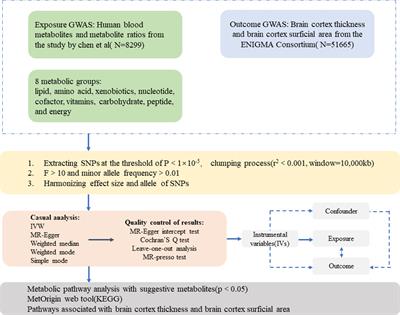Association between human blood metabolites and cerebral cortex architecture: evidence from a Mendelian randomization study
Background: Dysregulation of circulating metabolites may affect brain function and cognition, associated with alterations in the cerebral cortex architecture.However, the exact cause remains unclear.

. This study aimed to determine the causal effect of circulating metabolites on the cerebral cortex architecture. Methods: This study utilized retrieved data from genome-wide association studies to investigate the relationship between blood metabolites and cortical architecture. A total of 1,091 metabolites and 309 metabolite ratios were used for exposure.
The brain cortex surface area and cortex thickness were selected as the primary outcomes in this study. In this study, the inverse variance weighting method was used as the main analytical method, complemented by sensitivity analyses that were more robust to pleiotropy. Furthermore, metabolic pathway analysis was performed via MetaboAnalyst 6.0. Finally, reverse Mendelian randomization (MR) analysis was conducted to assess the potential for reverse causation. Results: After correcting for the false discovery rate (FDR), we identified 37 metabolites and 9 metabolite ratios that showed significant causal associations with cortical structures. Among these, Oxalate was found to be most strongly associated with cortical surface area (β: 2387.532, 95% CI 756.570–4018.495, p = 0.037), while Tyrosine was most correlated with cortical thickness (β: −0.015, 95% CI −0.005 to −0.025, p = 0.025). Furthermore, pathway analysis based on metabolites identified six significant metabolic pathways associated with cortical structures and 13 significant metabolic pathways based on metabolite ratios. Conclusion: The identified metabolites and relevant metabolic pathways reveal potential therapeutic pathways for reducing the risk of neurodegenerative diseases.
These findings will help guide health policies and clinical practice in treating neurodegenerative diseases.
Read the full article at the original website
References:
